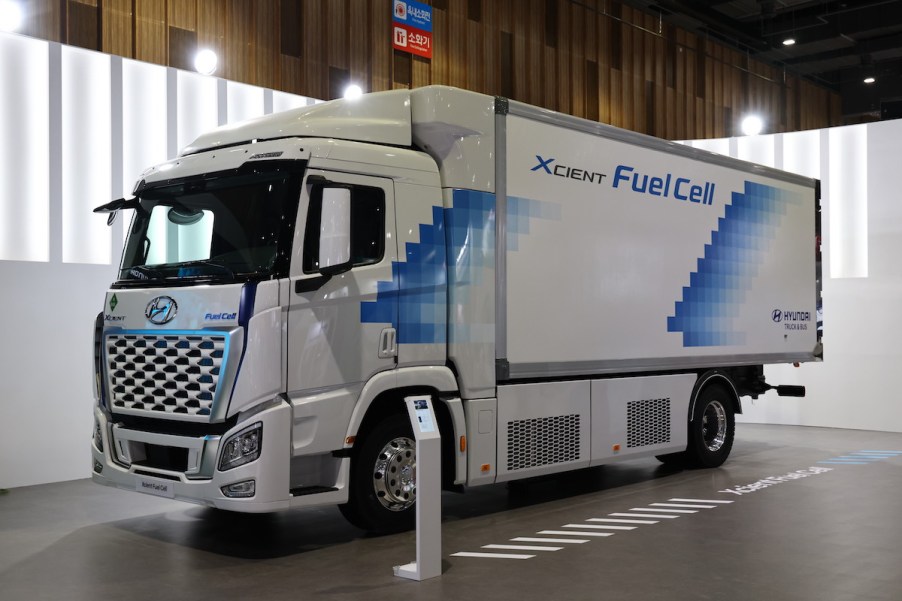
Hyundai Xcient vs. Nikola Tre: Which Is the Best Hydrogen Fuel Cell (FCEV) Truck?
While not as popular as electric vehicles or hybrids, hydrogen fuel cell vehicles (FCEVs) are starting to gain a foothold in the market for eco-conscious vehicles. Not only are automakers manufacturing FCEVs like the Hyundai Nexo and Toyota Mirai onto the consumer vehicle market, but they’re also working on FCEV options for commercial trucking fleets. Two of the most popular contenders are the Hyundai Xcient and Nikola Tre. Which option is better for commercial fleet operators looking to invest in hydrogen-powered vehicles?
Which is more powerful?

One of the most important considerations any fleet operator will have is how powerful the truck is. Horsepower, torque, and other related metrics will determine how much can be safely transported.
The Hyundai Xcient is well-designed in that regard, with a 180-kWh hydrogen fuel cell system consisting of two 90-kWh fuel cell stacks, and a 350-kW electric motor explicitly engineered for heavy-duty transport. As per wattEv2buy, the powertrain provides a maximum of 255 hp and 2508 lb-ft of torque.
Details about Nikola’s Tre FCEV are relatively scarce. However, as per AutoEvolution, the Tre FEV is designed with a 480 kWh system that generates a robust 644 hp. Interreg North-West Europe has also reported that the Nikola truck can produce 2,700 Nm (1,985.29 lb-ft of torque). So, considerably more horsepower but a bit less torque. Depending on the nature of the average payload, you may need more of one than the other.
Nikola also plans to offer a Nikola Two version with up to 900 miles of range. Again, details are scarce, but presumably, the Two will offer even more horsepower and torque than the base version.
Which has the better driving range?
While zero-emission vehicles reduce regulatory headaches and fueling costs, they can create headaches in other areas. With green vehicles, driving range and refueling are significant considerations. If a truck has a low driving range, it’ll need to take time out of each trip to refuel. And depending on their powertrain, refueling could take mere minutes or hours.
Hyundai and Nikola have prioritized driving range and refueling in their truck designs. Hyundai notes that the driving range for the Xcient is as much as 400 km (roughly 250 miles) when fully fueled. And depending on the ambient temperature when fueling, getting the Xcient back up to full capacity can take anywhere between 8 and 20 minutes. However, Hyundai also notes that a version already on the road in California has a driving range of 500 miles.
Nikola estimates that their Tre FCEV can travel up to 500 miles when fully fueled. They also cite that fueling fully will take up to 20 minutes, though their website has disclaimers about each figure. Specifically, they note that factors like different use cases, driving conditions, operator behavior, and vehicle characteristics can influence these numbers. Still, these figures offer a solid gauge of the Xcient’s performance capacity.
Which truck is bigger?
Of course, hauling more means you need more cargo capacity. So of the two models, it’s important to know which is bigger.
Well, the Hyundai Xcient is pretty big. The chassis designs are conventional, including 4×2, 6×4, and 8×4, with CNET noting that the 4×2 version can haul up to 36 tons. Hyundai offers the Xcient wheelbase sizes ranging from 222 inches to 326 inches. And in the trailers that sit atop these chassis, that means a lot of cargo-hauling volume.
The Tre FCEV is also reasonably sizable. Able to haul up to 41 tons as per Inside EVs, the Nikola offers more compact wheelbases than the Xcients. For example, the 6×2 Tre FCEV has a 186-inch wheelbase, while the 6×4’s is 222 inches. And the Tre FCV is only available in 6×2 and 6×4 versions, while the Xcient’s 8×4 version has a wheelbase more than 27 feet long.
So which is more ideal for commercial operators? Both trucks are comparable in these important regards, with options that can be tailored to configure almost any type of cargo. If you’re looking for the smallest option that holds the heaviest payload, the Nikola is probably the better choice. And if you need larger and more options, Hyundai’s Xcient fleet offerings are ideal.


